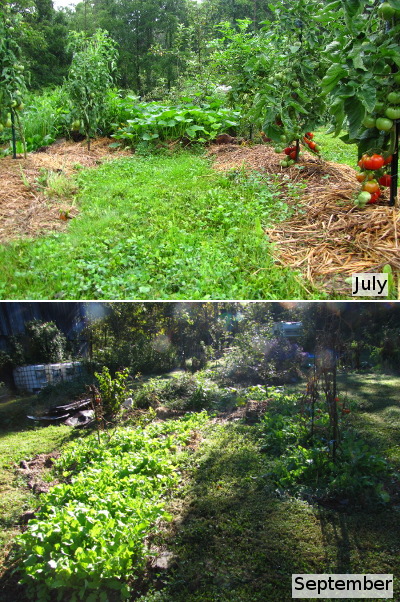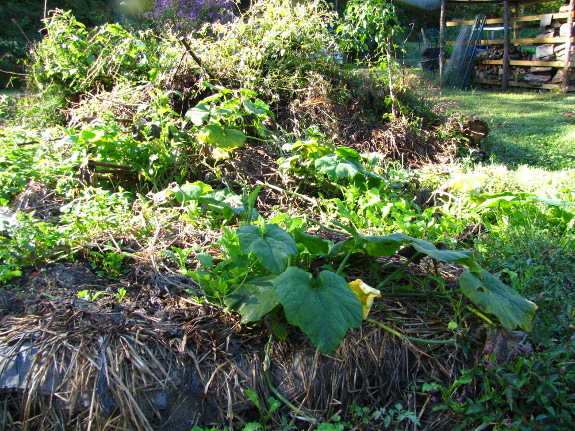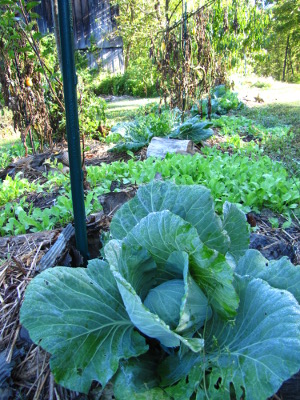
Vegetables in the forest garden
 Another strange technique I
began last year, but which seems to work well, is mixing annual
vegetables into the forest garden. My trees are still quite
young, so there are plenty of patches of full sun, and the vegetables give
me an incentive to drop by the forest garden every week rather than ignoring it
until the busy summer vegetable garden passes by.
Another strange technique I
began last year, but which seems to work well, is mixing annual
vegetables into the forest garden. My trees are still quite
young, so there are plenty of patches of full sun, and the vegetables give
me an incentive to drop by the forest garden every week rather than ignoring it
until the busy summer vegetable garden passes by.
But I have a feeling the
vegetables do more good than simply drawing my attention to the young
fruit trees. This spring, I noticed that the garden beds I'd
overwintered under a straw mulch didn't seem quite as vibrant as those
which had been home to winter
cover crops.
I've read that there are two types of soil microorganisms --- the living
food web, which
interacts with the roots of plants, and the dead
food web, which
decomposes organic matter. I suspect that if you don't have any
plants growing in a spot for a while, the living food web might perish
and take a while to regrow once you seed new crops.

 Like my haphazard
mulching, mixing
vegetables in with fruit trees is very theoretical at the moment, but
the technique doesn't seem to be hurting anything. I started out
the summer by filling every gap with tomatoes and butternut squashes,
then I added in cabbage and broccoli as the squash began to decline,
and I finished up the year by seeding oilseed radishes around the base
of tomatoes coming to the end of their lifespan.
Like my haphazard
mulching, mixing
vegetables in with fruit trees is very theoretical at the moment, but
the technique doesn't seem to be hurting anything. I started out
the summer by filling every gap with tomatoes and butternut squashes,
then I added in cabbage and broccoli as the squash began to decline,
and I finished up the year by seeding oilseed radishes around the base
of tomatoes coming to the end of their lifespan.
I don't really have a
way of measuring the results of my actions, but I can't think of any
negatives as long as the fruit trees aren't troubled by their
short-lived neighbors. And moving some veggies over to the forest
garden gives me more room to build soil in the main vegetable gardens
with cover crops.
Have you mixed trees and
tomatoes? As usual, I'm very curious to hear from other forest
gardeners who are busy thinking outside the box.
| This post is part of our 2012 Forest Garden lunchtime series.
Read all of the entries: |
Want more in-depth information? Browse through our books.
Or explore more posts by date or by subject.
About us: Anna Hess and Mark Hamilton spent over a decade living self-sufficiently in the mountains of Virginia before moving north to start over from scratch in the foothills of Ohio. They've experimented with permaculture, no-till gardening, trailersteading, home-based microbusinesses and much more, writing about their adventures in both blogs and books.
Want to be notified when new comments are posted on this page? Click on the RSS button after you add a comment to subscribe to the comment feed, or simply check the box beside "email replies to me" while writing your comment.

I haven't mixed the taller plants in the forest garden. I do a lot of herbs, garlc bulbs, onions and several asperagus roots. I do this as a permaculture practice and to make sure my fruit trees get water during the hot summer. Like you I tend to get caught up in the vege garden.
I am doing quite a few huggle piles around the pine forest. There are some sunny sights where we have had some treees thinned. So I decided to put some squashes and potatoes up there. The deer do not seem to like these 2 plants.
I read your articles about your hoop garden for the winter. I wanted to do one last year, but we were away from home. But this fall I did plant a salad garden in a raised bed. I have the hoops up and it is going so well. Thank you for your instructions and the pictures. I love your blog.
Mona --- Sounds like you've got lots of great experiments going! I agree that asparagus would make a good permanent addition to a forest garden, in a spot that will stay moderately sunny once the trees mature. It's great for attracting beneficial insects.
We'll be putting our hoops up in a week or two. Looking forward to another long winter of delicious greens!
Oh seeing all that green makes me homesick for new Hampshire- the garden looks so lovely and productive! I wanted to tell you that I enjoyed all the weekend homesteader kindle books so much, and the info is so practical that I will be buying the hard copy for my bookshelf. I really prefer "real" books anyway.
And one question, if you don't mind. Do you have some cover crop or ground cover in between your garden rows? It looks like there is something actually planted there.... just wondering.
Deb --- Thank you so much for the kind words about my books!
We allow grass and clover (and other short weeds) to grow in the garden aisles and just manage it with a lawnmower. You can read more about our aisles here.